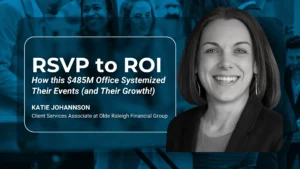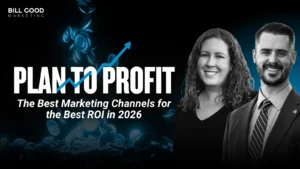Presumably, you are reading this article because you’re interested in financial advisor prospecting. So, before we do anything else, let’s define what prospecting actually is.
At the foundation of prospecting is this truth:
Many, if not most, of your new clients will come from people you have been in contact with for some time and who have come to feel comfortable with you.
Based on that truth, we can define prospecting as:
The activities that help you find, meet, and build relationships with people you don’t know who you want to do business with.
In the context of financial services, prospecting is not handing out business cards or cold calling without a plan. It’s not just buying a billboard or a 30-second radio spot. That’s advertising, and while it can help, it’s not effective prospecting.
Prospecting is an active endeavor. Think of the original prospectors, the gold seekers of the 19th century. The most successful ones didn’t just stick a pan in any old body of water and wait. They didn’t just find a random spot on the ground and start digging. They tried to find the places gold was likeliest to be. They combed the countryside, methodically searching for signs of mineralization. When they found a site worth exploring, they left no stone unturned in their search for something that glittered.
Over time, prospecting became less laborious and more advanced. Modern prospectors use geophysics and magnetic detection to find the greatest lodes. But even modern prospectors know that finding gold requires an investment in both time and capital.
The good news is that financial advisor prospecting has also become more advanced over the decades. But still, it remains an active, not a passive, activity. It requires knowing where to look. It requires knowing what to look for. It requires knowing what to do and say when you find a prospect.
It requires a strategy.
The Problem with Prospecting for Investment Advisors
You want to grow your financial planning business. Maybe you want to take your $10M and turn it into $20M. Maybe you want to take your $100M and turn it into $200M. Maybe you want to take your $1B AUM and…you get the idea.
But growing your business is hard, and you simply don’t have the time (or the capital) to waste trying to figure out what works. Maybe you’ve tried various marketing strategies before and they Just. Didn’t. Work. Maybe you’ve never done much prospecting before because you’re unwilling to “gamble” your precious time (or precious dollars) on a venture that might not work.
Either way, you want to grow – and you’re not.
The Solution for Investment Advisors
We have good news. The problem you’re experiencing is as old as the financial services industry itself – and we’ve personally helped thousands of investment advisors overcome it. Because the solution is actually simple. Not easy, mind you, but simple.
Don’t Reinvent the Wheel
Here’s the reason most financial advisors either don’t prospect or fail when they try. They don’t know what works. So, they try to reinvent the wheel, making the same mistakes that thousands of investment advisors before them did.
There are many types of prospecting strategies. (Here at Bill Good Marketing, we call them prospecting channels because each is like a channel that new leads can flow through on their way into your office for their first appointment.)
Seminars are one. Referrals, webinars, podcasts, and centers of influence with CPA’s and estate planning attorneys are others.
In this article, we’ll run through a few. But regardless of which channel you choose, how much simpler would it be if you could emulate what the top investment advisors are doing in that channel, rather than throwing things against the wall to see what sticks?
How much nicer would it be if you could limit your time and money on things that you know work because other advisors are doing them?
How much more successful could you be if you simply implemented more prospecting best practices?
The answer, of course, is, “A heckuva lot.” (That’s a technical term.)
Why You Should Always Be Prospecting as a Financial Advisor
Newton’s First Law of Motion states, “An object in motion tends to stay in motion, while an object at rest stays at rest – unless acted on by an outside force.”
A similar law applies to prospecting.
“A business in motion will stay in motion. A business at rest, dies.” – Bill Good, Founder & Chairman of Bill Good Marketing
There are many reasons why you should always be prospecting. Regardless of your situation, your goals, your location, the time of year, or whatever, you must always have a full pipeline of potential clients coming in. Of course, how you prospect and how many prospective clients you need will vary depending on your circumstances. But prospecting itself should never, ever stop.
The problem of momentum is perhaps the most pressing reason. Time and again, we’ve seen advisors who stopped prospecting struggle to get going again. It’s hard to build a pipeline from scratch, and most effective prospecting channels take time to build up.
Here’s another reason. If you’re not prospecting your area, you can be quite sure someone else is.
If you felt a chill running down your spine just now, that’s good! It means there’s still hope for you. You don’t want another financial advisor to steal all those ideal clients, do you? “Nature, red in tooth and claw,” as the saying goes. Natural selection exists in the wealth management industry and the wild, and the last thing you want is to be driven to extinction by stronger competitors.
The third reason you should always be prospecting is the most important.
It’s time to face facts: You will lose assets during your career. Attrition is just a fact of life, even if it can be mitigated to some extent. Your current clients die. Your clients move away. Your clients get older and start taking distributions, and thus, money, out from under your management. Your clients get seduced by some other financial advisor and take their assets with them. Recessions and bear markets happen. That means your assets could take a hit just by virtue of the markets going down.
In short, if you’re not actively trying to grow, you are backsliding. And once you start backsliding, it’s hard to stop and reverse course.
There’s that pesky Law of Motion again.
Finally, we’ve found that financial advisors who don’t have any form of outreach often get complacent – with their business, and even with their existing client base. They tend to forget the need to continually evolve, improve, and add value. That’s a problem because current clients can sense that complacency. Staff members can become infected by it. Pretty soon, these wealth management professionals are like a dull knife suddenly pulled from the drawer in time of need – only for the wielder to find it doesn’t really work so well anymore.
Whether you need to grow by a lot or a little, whether you’re young or old, just starting your career or just finishing, you should always be prospecting.
Sir Isaac Newton said so.
3 Barriers to Prospecting and How to Overcome Them
All that said, most financial advisors know they need to prospect and get new clients. But knowing something and actually executing it are two different things. In our experience, most advisors who don’t prospect consistently get stuck behind three common mental barriers.
Barrier #1: “I know I need to prospect, but I don’t have the time.”
Time for some brutal honesty. When advisors say, “I want to, but I don’t have the time,” it’s often – not always, but often – code for, “I’m not effectively using the time I have.”
If you know you need to prospect but don’t think you have the time for it, the solution is obvious. We need to look at how you’re using your time and whether your time management is efficient or not.
When advisors believe they don’t have time to prospect, it’s usually because:
- They are spending more time than they need on other activities.
- They don’t have a plan for how they divide up their time.
- They are not delegating activities that can and should be delegated.
One way to overcome the first two issues is to create what’s known as a Model Day. This is where you group similar actions and activities into their own time blocks. We call these time blocks “mini days.” The most efficient financial business owners have mini days for:
- Calling current clients and prospects.
- Face-to-face meetings regarding financial advice with your client base and prospects.
- Conducting investment research.
- Creating financial plans, proposals, or investment portfolios.
- Handling administrative tasks, like answering email.
- Activities related to prospecting – such as follow-up correspondence and in-person meetings.
When creating a Model Day, you should also position each time block at the time of day when you are statistically most likely to be successful. (For example, make all of your sales phone calls in the morning, usually between 8:00-10:00 AM.)
That’s it. With a Model Day, you can develop momentum and focus that you will not enjoy if your day has no structure. Most importantly, you will use the time you have more effectively, which means you can create time for lead generation and honing your sales process.
Delegation is another critical tool for using your time more effectively. We’ve visited thousands of financial advisor offices during our time in business and have seen firsthand how advisors, especially CFPs, burden themselves with tasks they don’t need to do themselves.
Here are some of the most common:
- Answering phone calls and scheduling their own appointments.
- Answering basic client questions and handling every client request, just because the client said: “They’re more comfortable if so-and-so does it.”
- Filling out/processing standard forms and paperwork.
- Entering data into their CRM.
- Drafting/sending standard correspondence, like pre- and post-appointment messages.
While wanting to ensure that client service and back-office operations get done correctly and accurately, these are all tasks your team should be doing for you. Not only will it free up your time, but it will also almost always lead to better service than you’re currently providing.
If you don’t have the team to help take on those duties, we can help you with recruiting and hiring, too.
Finally, if neither of these is enough on their own, and making more efficient use of your time doesn’t cut it, you have another recourse: Choose the least time-intensive forms of prospecting.
Every prospecting idea requires some investment of your time, of course, but some are more time-hungry than others. To be successful at cold calling, for example, requires an enormous time investment.
What are some of the least time-intensive forms of client acquisition?
Think referrals, centers of influence, and developing your social media and LinkedIn connections. But you should also consider seminars.
While seminars do require a good deal of time on the front end (as you develop your list, your presentation, find a good location, etc.), they are perfect for financial advisors who are comfortable delegating to their teams. With a little practice, you can get to the point where all you need to do is show up and give the presentation.
Barrier #2: “I know I need to prospect for new clients, but I don’t have the money.”
Most common for advisors who are just starting out, this is a real concern, no question. But just as you can choose less time-intensive prospecting techniques, so, too, can you choose forms that are less capital-intensive.
Cold calling is definitely at the top of the list – and yes, it still works. (You just have to do it right.) In fact, cold calling remains the quickest and most direct way for a new advisor to grow their retirement planning business. It’s also perfect for more established advisors who need to restart their prospecting efforts and get their pipeline moving again.
Referrals are another fabulous low-cost way to reach your target market. Keep in mind, though, that while referrals are perhaps the most powerful way to grow over the long term, they are rarely enough in the short term.
Finally, networking events are an excellent choice for advisors who have time but lack capital. Joining various organizations or becoming more active in your community is a great way to network, and in many cases, it only requires your time and energy. Not your wallet.
The Importance of Best Practices
Here’s an underappreciated way to save money on prospecting: When you’re first starting out, focus less on results and more on best practices.
A best practice is a technique, method, process, or activity that is more effective at delivering a particular outcome than any other. Best practices can also be defined as the most efficient (least amount of effort) and effective (best results) way of accomplishing a task, based on repeatable procedures that have proven themselves over time for large numbers of people.
Go out of your way to learn the various best practices of whatever form of lead generation you choose to pursue. By doing more of what other successful financial planners are already doing, you can greatly reduce your chance of throwing money away on bad prospecting ideas or inexpert execution. And in the long term, your odds of prospecting success go way up.
Barrier #3: “I don’t believe financial advisor prospecting works.”
Here’s the skinny about money, time, and your prospecting process. You have to match your available capital and time with how much you want to grow. If you want to grow fast and you don’t have time or capital, that’s a difficult combination. Fortunately, most financial advisors who lack capital tend to have lots of time, and the reverse is also true. CFPs with little time, often have the capital.
So, the formula is to choose the least intensive form of whatever it is you lack – and then balance that against whatever your goals are.
For example: if you currently have $75M in AUM, you probably have the capital you need, but time may be an issue. But if your goal is to bring in another $25M this year, you’ll probably need to invest both capital and time. If that’s not possible, your only recourse is to set a different goal – say, $10M.
On the other end of the scale, if you’re currently at $5M and you want to get to $20M, it’s likely you simply don’t have the capital to invest in, say, an expensive seminar program. That means you must either set aside an enormous amount of time on cold calling or networking, or, again, switch to a more modest goal.
However, if you’re currently at a place in your career where you have both the time and the money to prospect aggressively, go ahead and shoot for that $15M or $30M year. In fact, you can aim higher if you want! We’ve personally coached investment advisors who have brought in $100M or more every calendar year.
The reason we emphasize all this is because a common mistake many financial advisors make is to set improper prospecting goals. Some advisors set the bar too high, given the time or capital they have to invest, and get discouraged when they fail to reach it. Other financial advisors set the bar too low and become disheartened that their growth isn’t as comparable as their peers.
When either happens, chances are good that the advisor will waste more money and time or stop prospecting altogether.
We liken it to weight loss. The diet industry has convinced a lot of people that real weight loss must be rapid and dramatic. How many times have you seen commercials where people say, “I lost 75 pounds in only 30 days!” or similar outlandish statements? But for most people, losing so much weight so fast is nearly impossible – and probably unhealthy. And even for those who can, science has proven that most will regain it all back.
So, what do you think happens when someone sets an unrealistic goal for losing weight? They struggle, they get frustrated…and they quit.
Thankfully, weight loss doesn’t have to be dramatic. As the tortoise proved to the hare, slow and steady really does win the race. Oftentimes, the most successful people are the ones who try to lose, say, one pound a month. They set goals that are not only more attainable but sustainable, too!
The same is true with prospecting. As stated prior, we’ve coached advisors who bring in over $100M a year. While that’s undeniably impressive, raw numbers are not the only measure of success. Maybe the advisor spent so much time prospecting that their relationship with their family suffered. Maybe the advisor spent so much money prospecting that all that new business barely made a difference in their bottom line.
It’s not unheard of to meet a financial advisor who grew by $50M and is absolutely miserable, and then hear from an investment advisor who grew by $5M and is absolutely loving life. Size and speed are relative; progress is what counts.
Now, we’re not saying you shouldn’t set ambitious goals. Just be sure to always set realistic, sustainable goals. You must set your prospecting goals based on:
- Where you are in your career.
- How much capital and time you’re prepared to invest.
- What level of growth your team can support.
The smarter your prospecting goals, the more likely your prospecting will succeed. It’s that simple.
Get Started on New Prospecting Ideas with Bill Good Marketing
At Bill Good Marketing, we know that prospecting is the lifeblood of your financial planning practice.
Whether you’re interested in exploring innovative new prospecting techniques or harnessing methods that may seem “dated” but still pack a punch, we’ve got you covered.
With over 40 years in the industry, we’ve helped investment advisors across the country grow exponentially. Our strategies and processes are designed to address every demographic and target audience.
From digital marketing and email marketing to SEO and the optimization of your social media, we ensure that your efforts are tailored to deliver maximum impact. We’ll help you craft a compelling value proposition that speaks directly to your prospective clients, guiding them smoothly through the sales process.
Ready to elevate your prospecting game?
Contact us or call 888-495-7303 to learn more about how Bill Good Marketing can support your growth with effective prospecting strategies and techniques. We’re here to help you succeed.
About the Author

Andrew D. White is the Director of Marketing at Bill Good Marketing and part of the team behind Altitude, the AI-native CRM built exclusively for financial advisors. He develops marketing strategies that strengthen client relationships, accelerate asset growth, and reduce time spent in the office. With hands-on experience working alongside top advisors, Andrew focuses on proven systems that elevate prospecting, branding, and practice management into predictable growth engines.




